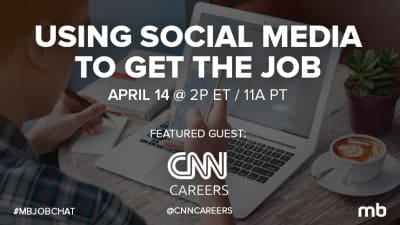True, social media can seem like a time suck. But you shouldn’t minimize social media activity while working to land that new gig—especially if you’re looking for a social media job.
On the contrary, you’ll likely need to spend even more time, energy and creativity on the socials in order to achieve your goal of finding a new gig.
Also on Mediabistro


The key is to start simple to build momentum, thinking long-term and with creative flair about the effort, and stay focused on the end game: a new job that’s right for you.
Here are some quick—but nonetheless helpful—social media tips that can be done immediately and with minimal effort:
1. Review Your Contacts. You know a lot of people across your social networks, from Linkedin to Twitter to Facebook—so many in fact, that you probably need to refresh your memory about exactly who you are connected to.
Scroll through your friends, followers and connections and create a “to contact” list, which you can then prioritize and begin reaching out to with personal, tailor-made notes.
Through this process you’ll also realize there are key professional people from your past and present who aren’t in your network—this is also a good time to request connections (again, with a personal note).
2. Post More. Begin posting relevant, industry-specific updates, articles and essays via your profile on LinkedIn, the most career-centric social network, and definitely something all job seekers should be active on.
This gets your profile active and in front of not only your existing connections, but the larger LinkedIn community.
3. Update Your Digital Platform. Yes, it’s probably time for a total revamp, but start simple and build from there. The best place to begin: Take a new, professional photo and upload it to all your profiles (Facebook, LinkedIn, Twitter, etc.).
You don’t have to completely redesign and fully update all your channels, but this new photo on all your social media presences sends a positive message and establishes, at a high level, a streamlined platform.
Gearing up with those simple tactics sets in motion a proactive social media job search gameplan, and helps establish the foundation for larger scale, more creative efforts that will have more impact.
It is, after all, bigger moves that are going to lead to better traction in terms of landing that new job. Here are some strategies to get you moving in that direction.
4. Share Your Story, Expand Your Network. Build a compelling narrative, with a beginning, middle and end—the end being you landing a job, and grow an audience for it through a well-planned social media campaign.
It’s a way to expand your network in a creative, groundbreaking way. The better your storytelling, the bigger the impact and the larger your potential audience. A few solid examples of this can be found in the ascendant podcasting space:
The Intern: A podcast by Allison Behringer about navigating a new tech job in New York City.
Millennial: In season 1, Megan Tam documented her post-graduation life, which, naturally, involved landing a job.
First Day Back: A podcast by Tally Abecassis in which she documents her efforts to relaunch her career after an extended maternity leave.
Hearing honest and insightful stories around a subject, topic or industry resonates in the social space. Though the above examples are podcasts, any medium will do—photography via Instagram, or essay writing via Medium.
There are plenty of ways to come at this. And once you’ve completed your job hunt story, you’ll have a new one to tell—all the cool stuff you will be doing in your new role.
5. Become a Connector, Grow into an Influencer. You’re seeing endless posts for jobs, and though many of them won’t be for you, they are right for someone else. Share this valuable information that you come across with your social media networks. And keep upping the game.
You don’t want to overwhelm everyone’s feeds, but begin to connect with and share news and insights from the influencers in your industry of focus, making sure to add in your own intelligent commentary.
Consider collecting all this information and sharing it on your website in the form of blog posts, and on Medium, as well as disseminating it in the form of a weekly newsletter (via TinyLetter or MailChimp).
Over time, not only will your network grow, but so will your influence. Instead of hearing about new opportunities through job listings, you’ll hear directly from a source, and therefore before most everyone else.
Hot Pod, an extremely popular newsletter by Nick Quah about the podcasting space featuring insightful commentary and industry news, started out as a TinyLetter. It built up a following, continued to gain traction, and Quah is now building out the project to include new products and events.
He’s now a key player in a growing industry.
6. Build and Launch a Creative Campaign. This should be based on your interests—an exercise in challenging yourself and flexing your creative muscles.
It doesn’t necessarily have to be aligned with your industry or professional arena, but it should demonstrate your skills at developing and managing a creative project, as well as building an audience through social media.
The overall campaign can serve as an engaging showcase, one that might come to the attention of prospective employers not because you’ve told them about it, but because someone else did.
Two high-level examples, Forty Days of Dating and #The100DayProject, went viral—not an easy feat, and perhaps you shouldn’t expect for that to happen, but good models nonetheless.
Here are a couple smaller scale projects that didn’t necessarily reach that level of attention, but still gained traction and built up a sizable audience:
100 Haikus in 100 Days: Courtney Symons challenged herself to write and post a haiku every day for 100 days on Instagram, and ended up developing a nice following and lead to a popular, sharable showcase of creative work.
#colorcolourlovers: In this Instagram-focused community project in which colors are specified over the course of six weeks, participants post photos showcasing those colors.
Not quite sure what to launch on your own? Then begin by participating in an existing, social media-based project—engage in #The100DayProject, #colorcolourlovers or Gumroad’s Small Product Lab, a very cool project-focused community effort in which you build and launch a digital project in 10 days.
All of these efforts—no matter their scale or level of effort—provide solid foundation building, as well as a creative outlet that lets you connect, share and grow your influence in the social space. The momentum will lead to bigger and better as you move forward.
Jeffrey Yamaguchi (jeffreyyamaguchi.com | @jeffyamaguchi) is a MediaBistro instructor whose courses include Fundamentals of Digital Marketing and Social Media Marketing. He also serves as the Director of Audience Development at Narativ, a new podcast venture.










